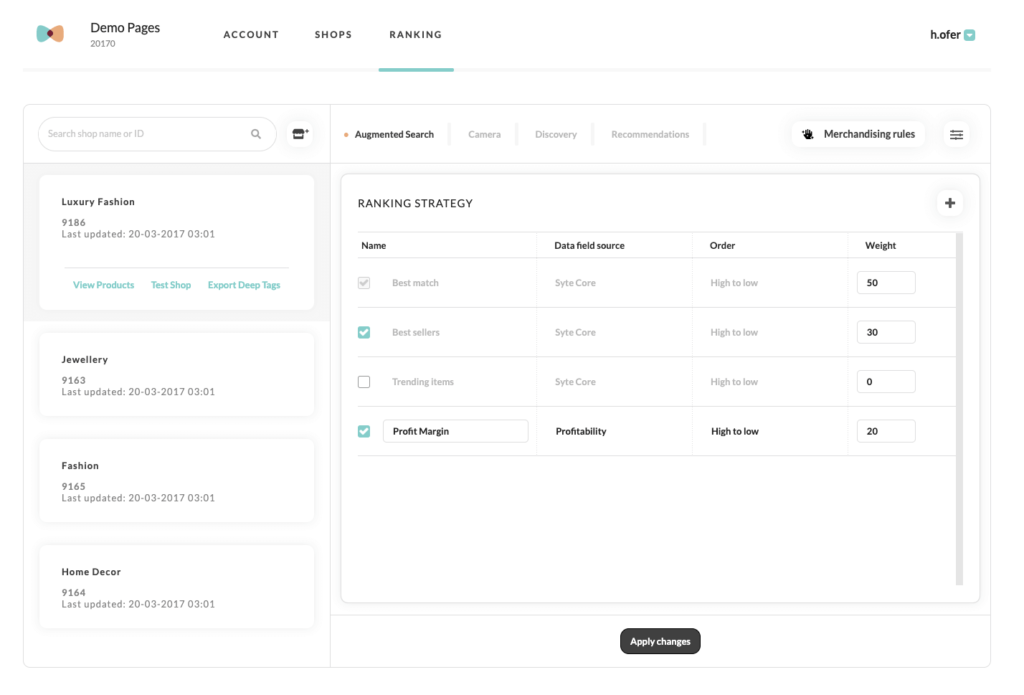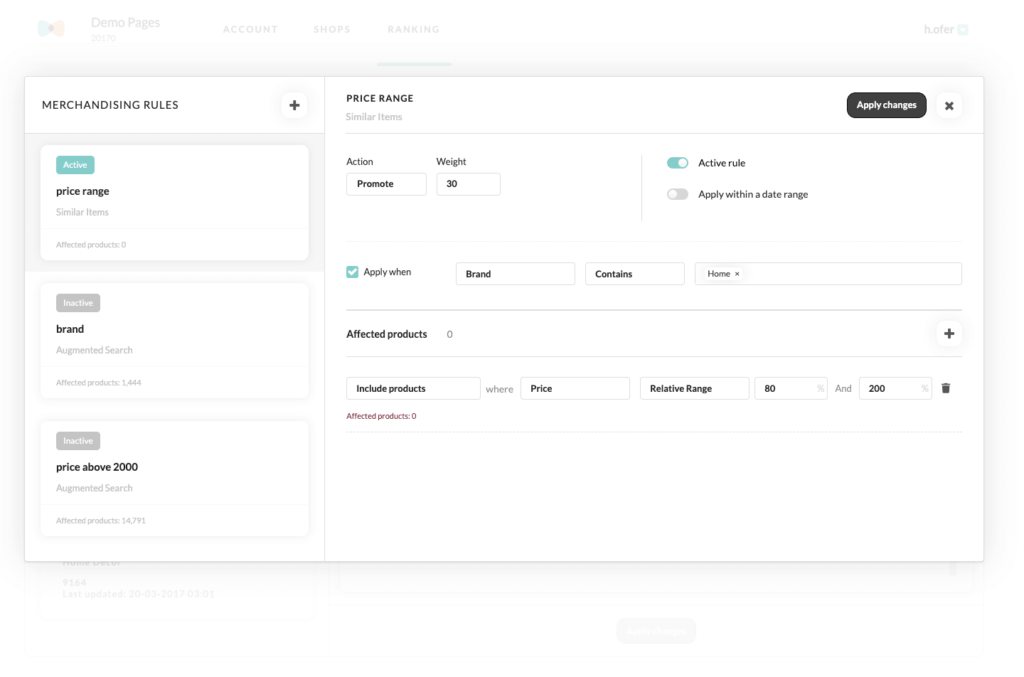Merchandising is a measured science, a delicate balance between engaging shoppers and getting eyes on the products you need to sell.
In brick-and-mortar stores, this plays out in carefully designed showrooms, clever floor plans, and the strategic placement of key categories, like your denim wall or your new winter collection.
You can switch up the look of your store and reposition new merchandise at a regular cadence, but in the intervening days or weeks, products remain static.
Online, without the showrooms, glass cases, or clothing racks, you have near endless opportunity to adjust, update, and optimize your “layout,” or the order of how you present products on your site.
Your eCommerce merchandising strategy is one of the most powerful tools you have for capturing shopper attention and driving conversion.
In fact, since 70% of shoppers view only the first 30 site search results after entering a query, and 86% click only on the first five items suggested in recommendation carousels, controlling which products appear first is critical.
As part of Syte’s Discovery Console, we’ve recently released two new core capabilities that are designed to promote effective eCommerce merchandising: Ranking Strategies and Merchandising Rules.
Let’s take a closer look at how they work.
Ranking Strategies: Your Approach to Product Placement
Depending on your business model, the time of year, and the current status of your inventory, you may want to promote different types of items throughout your website. For example, if you’re focused on cleaning out the last of your seasonal products before ordering more inventory, you may want shoppers to see items with low stock availability — or older items — first.
If you have a strong brand community, it might be more important for you to ensure that products with the highest reviews are displayed more prominently, since the power of social proof will be even more impactful.
Ranking Strategies represent the broader approach you take to eCommerce merchandising, and they impact how your products are displayed across all Syte’s solutions, from search results to recommendation carousels.
By combining the data from your product feed with your eCommerce events, you can configure Ranking Strategies for a range of parameters, including stock availability (high or low), size availability, high margin items, new or old items, items with positive reviews, best sellers, recently trending items, and more.
Configuring Your Ranking Strategies:
Within Syte’s Discovery Console, you can configure the weight of each of these parameters between 0-100, which will, in turn, assign a score to each SKU in your inventory, impacting the order in which they are displayed. Multiple ranking factors can then be combined and prioritized to enable the dynamic promotion of relevant items.
When setting up your Ranking Strategies, it’s important to consider the varying scenarios your customers might encounter while shopping. Every brand will need to test to find their ideal setting for their business objectives while providing the best possible customer experience. You can create separate Ranking Strategies for each Syte product to support a variety of business and CX goals.
Since Syte’s products are designed to surface the most relevant items, visual similarity or “best match” will always be a top priority. With that as your starting point, you can configure each additional parameter to align with your goals.

Below, you’ll find recommended configurations that can serve as a general guideline when implementing Ranking Strategies.
Business Case 1: Promoting best sellers and trending items:
- Set “Best Match” to 70
- Set “Best Sellers” to 20
- Set “Trending Items” to 10
This way, shoppers are sure to find items that suit their query with tried and true best sellers among the top results. When it comes to Augmented Site Search results, you may want to give an even higher weight to best sellers and trending items, since without an inspiration photo to search from, shoppers are often using generic terms like “jeans,” for which there could be dozens or even hundreds of “best match” results.
Business Case 2: Promoting top-grossing items:
- Set “Best Match” to 60
- Set “Personalized Suggestions” to 20
- Set “Profit Margin” to 20
Since your high-margin products may not always be the ones most popular with shoppers, we recommend adding personalized suggestions into the mix to get a healthy balance between items shoppers will surely love and the ones that help you reach revenue goals.
Merchandising Rules: Zeroing in on the Moments That Matter
While Ranking Strategies help you support your business goals more broadly, Merchandising Rules give you the flexibility to cover a variety of use cases as they relate to specific products or product collections.
Each rule you set up enables you to dictate a particular action for a given product or collection: promote, demote, exclude, or include only. You can set these rules up to apply to each of Syte’s products to give you customized control of your inventory display for a given scenario.
Every brand has different goals, as well as shoppers with different needs and expectations, so there’s a nearly endless variety of Merchandising Rules you could apply to maximize conversion.

Let’s take a closer look at a couple of common scenarios where leveling up with Merchandising Rules pays off:
Scenario 1: You want to promote items that are on sale to customers shopping at a lower price point
If Ranking Strategies enable you to promote all the items you have on sale, think of Merchandising Rules as your way to narrow down the specific audience that sees more discounted items.
For example, you can promote sale products to shoppers who use the term “casual” or “jeans” in on-site searches. Shoppers using keywords like these aren’t shopping for a major event and are likely to have a lower budget in mind, so by promoting discounted items related to the query, you’re increasing the relevance of their search results. The more relevant the items and the price, the greater the purchase likelihood.
Scenario 2: I want promoted products to be close in price to the items my shoppers are interested in
As consumers, we all know the feeling of clicking through on an appealing item only to balk at the price tag. The shock can be enough to send you running from the website. So when it comes to your shoppers, you want to make sure recommended products are ones that they will feel comfortable adding to cart.
To do this, you can set up a Merchandising Rule that promotes only items within a +/-30% price range of the item a customer is looking at on a product detail page.
These rules can be adjusted to apply to everything from seasonality to particular brand promotions (think: your in-house brand), to trending items, inventory control, and more.
Test, Optimize, and Drive More Revenue With Smart eCommerce Merchandising
Just as with every aspect of your online experience, getting eCommerce merchandising “right” relies on customizing your strategy. Within Syte’s Discovery Console, you can not only set up the Ranking Strategies and Merchandising Rules that support your goals, but you can also continually adjust, test, and optimize to ensure you hit your conversion and revenue targets. These solutions are designed to be as flexible as possible, adapting to changes in your inventory, pricing strategy, and even your vision for the ultimate customer experience, so you can create the most impactful product discovery journeys for your brand.